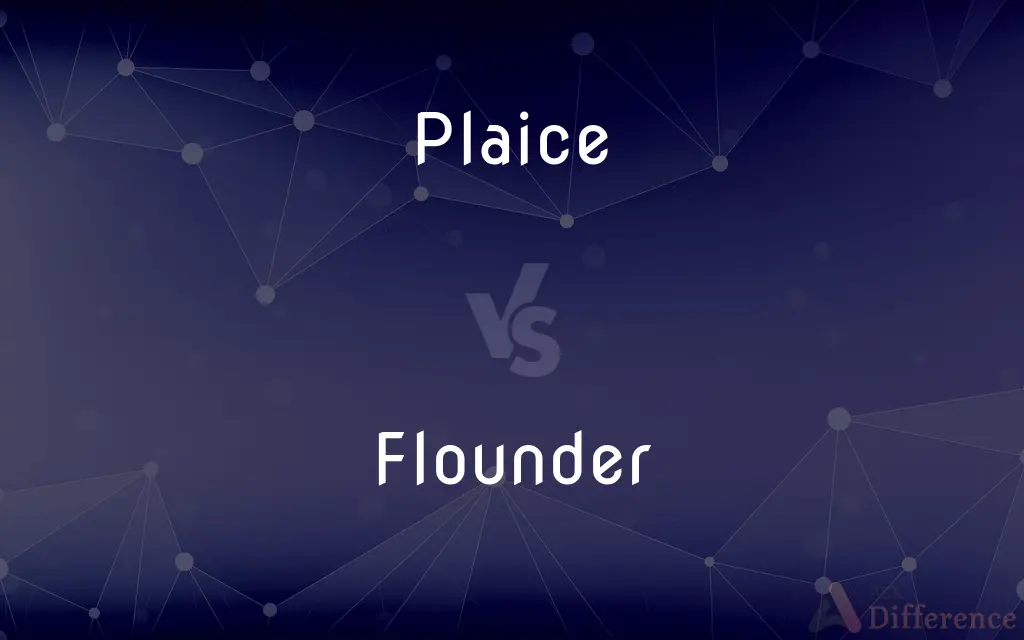Plaice vs. Flounder — What's the Difference?
By Maham Liaqat & Fiza Rafique — Updated on April 7, 2024
Plaice is a flatfish species known for its bright orange spots, distinct in North Atlantic regions. Flounder encompasses a wider group of flatfish, found in various environments worldwide.

Difference Between Plaice and Flounder
Table of Contents
ADVERTISEMENT
Key Differences
Plaice, specifically referred to as European plaice, is characterized by its smooth, dark green skin with conspicuous orange spots and a white underside, thriving mainly in the cold waters of the North Atlantic. Flounder, on the other hand, represents a broader category of flatfish species, with members inhabiting oceans around the globe, varying greatly in color and habitat.
In terms of culinary use, plaice is highly valued for its sweet, mild flavor and fine, flaky texture, making it a popular choice in European cuisine. Flounder, while also appreciated for its taste, includes a variety of species such as the summer flounder (fluke) and the winter flounder, each with its unique culinary qualities and textures.
Plaice typically prefers sandy or muddy sea bottoms and is found at depths ranging from shallow waters to up to 200 meters. Flounder species adapt to a wide range of habitats, from estuarine areas to deep sea environments, displaying a remarkable ability to camouflage with their surroundings.
Reproduction and life cycle aspects also distinguish plaice from many flounder species. Plaice engage in a seasonal migration to spawn, laying eggs in specific areas that offer protection and suitable conditions for the offspring. Flounders, depending on the species, may have varied spawning behaviors and locations, often related to temperature and salinity conditions of their habitats.
Despite these differences, both plaice and flounder share common features typical of flatfish: a laterally compressed body, both eyes on one side of the head after metamorphosis, and a bottom-dwelling lifestyle, making them fascinating subjects of study for marine biologists and a prized catch for fishermen.
ADVERTISEMENT
Comparison Chart
Scientific Name
Pleuronectes platessa
Multiple genera and species
Habitat
North Atlantic, sandy or muddy bottoms.
Global, varied habitats including estuarine and deep-sea environments.
Identification
Dark green skin with bright orange spots.
Varies widely; generally camouflaged with the seabed.
Culinary Value
Sweet, mild flavor; fine, flaky texture.
Varies by species; generally valued for its taste.
Reproduction
Seasonal migration for spawning.
Spawning behaviors and locations vary by species.
Compare with Definitions
Plaice
A flatfish species known for its distinctive orange spots and preference for cold North Atlantic waters.
The plaice, with its unique spots, is easily distinguishable from other flatfish.
Flounder
Refers to various flatfish species adaptable to different marine environments.
Flounder species include both the summer and winter flounders, each adapted to its niche.
Plaice
Prefers sandy or muddy sea floors, usually found at depths of up to 200 meters.
Divers frequently observe plaice blending into the sea floor's texture.
Flounder
Inhabits a wide variety of environments, from shallow bays to deep ocean floors.
Some flounder species are known to dwell in surprisingly shallow waters.
Plaice
Subject to fishing regulations to ensure sustainable populations.
Fishing quotas for plaice are carefully managed to prevent overfishing.
Flounder
Displays diverse spawning habits, influenced by environmental conditions.
The spawning season for flounders can vary significantly depending on their habitat.
Plaice
Highly prized in cuisine for its flaky texture and mild taste.
Chefs often prepare plaice with minimal seasoning to highlight its natural flavor.
Flounder
Varies by species, with some under more threat due to habitat loss and overfishing.
Conservation efforts for flounder focus on habitat preservation and regulating catch limits.
Plaice
Engages in seasonal migrations to spawn in specific, suitable areas.
Each spring, plaice migrate to their spawning grounds, an event tracked by marine biologists.
Flounder
Offers a range of flavors and textures, depending on the species.
Flounder is versatile in the kitchen, suitable for frying, baking, or broiling.
Plaice
Plaice is a common name for a group of flatfish that comprises four species: the European, American, Alaskan and scale-eye plaice. Commercially, the most important plaice is the European.
Flounder
Flounders are a group of flatfish species. They are demersal fish, found at the bottom of oceans around the world; some species will also enter estuaries.
Plaice
A large edible marine flatfish (Pleuronectes platessa) of European coastal waters.
Flounder
To move clumsily or with little progress, as through water or mud.
Plaice
Any of various other flatfishes, such as Hippoglossoides platessoides of northern Atlantic coastal waters.
Flounder
To act or function in a confused or directionless manner; struggle
"Some ... floundered professionally, never quite deciding what they wanted to do" (Steve Olson). See Usage Note at founder1.
Plaice
Several similar marine flatfish of the righteye flounder family Pleuronectidae:
Flounder
The act of floundering.
Plaice
Pleuronectes platessa (European plaice), commonly found in the North Sea and Irish Sea, with smooth brown skin and red or orange spots.
Flounder
Any of various marine flatfishes chiefly of the families Bothidae and Pleuronectidae, including several important food fishes.
Plaice
Hippoglossoides platessoides (American plaice), of the North American Atlantic.
Flounder
A European species of flatfish having dull brown colouring with reddish-brown blotches; fluke, European flounder, Platichthys flesus.
Plaice
Pleuronectes quadrituberculatus (Alaska plaice), of the eastern North Pacific.
Flounder
(North America) Any of various flatfish of the family Pleuronectidae or Bothidae.
Plaice
Acanthopsetta nadeshnyi (scale-eye plaice), of the western North Pacific.
Flounder
A bootmaker's tool for crimping boot fronts.
Plaice
Liopsetta glacialis (polar plaice)
Flounder
(intransitive) To act clumsily or confused; to struggle or be flustered.
He gave a good speech, but floundered when audience members asked questions he could not answer well.
Plaice
A European food fish (Pleuronectes platessa), allied to the flounder, and growing to the weight of eight or ten pounds or more.
Flounder
(intransitive) To flop around as a fish out of water.
Plaice
Flesh of large European flatfish
Flounder
(intransitive) To make clumsy attempts to move or regain one's balance.
Robert yanked Connie's leg vigorously, causing her to flounder and eventually fall.
Plaice
Large European food fish
Flounder
To be in serious difficulty.
Flounder
A flatfish of the family Pleuronectidæ, of many species.
Flounder
A tool used in crimping boot fronts.
Flounder
The act of floundering.
Flounder
To fling the limbs and body, as in making efforts to move; to struggle, as a horse in the mire, or as a fish on land; to roll, toss, and tumble; to flounce.
They have floundered on from blunder to blunder.
Flounder
Flesh of any of various American and European flatfish
Flounder
Any of various European and non-European marine flatfish
Flounder
Walk with great difficulty;
He staggered along in the heavy snow
Flounder
Behave awkwardly; have difficulties;
She is floundering in college
Common Curiosities
Is there a conservation concern for plaice and flounder?
Conservation status varies; plaice and certain flounder species are managed through fishing regulations to ensure sustainable populations, with some flounder species facing greater threats due to habitat loss and overfishing.
How do plaice adapt to their environment?
Plaice camouflage with the sea floor using their dark green skin with orange spots, blending into sandy or muddy bottoms.
What are the main habitats of flounder?
Flounder species are adaptable, living in a range of environments from estuaries to deep sea floors, often camouflaging with their surroundings.
What distinguishes plaice from flounder?
Plaice is a specific species known for its orange spots and North Atlantic habitat, whereas flounder refers to a broader group of flatfish species found worldwide.
Are plaice and flounder found in fresh water?
Both plaice and flounder are primarily marine fish, though some flounder species can adapt to brackish waters of estuaries.
What is the significance of both eyes being on one side in plaice and flounder?
This adaptation allows them to lie flat on the ocean floor while keeping a lookout for predators and prey, crucial for their bottom-dwelling lifestyle.
What culinary preparations suit plaice best?
Plaice is best prepared with light seasonings to highlight its natural flavor, often baked or broiled.
How do the reproductive habits of plaice and flounder differ?
Plaice have a specific seasonal migration pattern for spawning, while flounder species may exhibit varied spawning behaviors depending on environmental factors.
Can plaice and flounder be used interchangeably in cooking?
While both can be used in various dishes, they may offer different flavors and textures. Plaice is particularly noted for its fine, flaky texture and mild taste.
Can flounder change color?
Yes, many flounder species can change color to match their environment, a camouflage technique to evade predators and ambush prey.
What challenges do plaice and flounder face in the wild?
They face challenges such as habitat degradation, climate change, and overfishing, impacting their populations and ecosystems.
How do plaice and flounder contribute to their ecosystems?
As bottom dwellers, they play significant roles in the marine food chain, controlling populations of smaller prey and serving as food for larger predators.
Share Your Discovery

Previous Comparison
Wise vs. Vice
Next Comparison
Dimension vs. DimensionalityAuthor Spotlight
Written by
Maham LiaqatCo-written by
Fiza RafiqueFiza Rafique is a skilled content writer at AskDifference.com, where she meticulously refines and enhances written pieces. Drawing from her vast editorial expertise, Fiza ensures clarity, accuracy, and precision in every article. Passionate about language, she continually seeks to elevate the quality of content for readers worldwide.















































